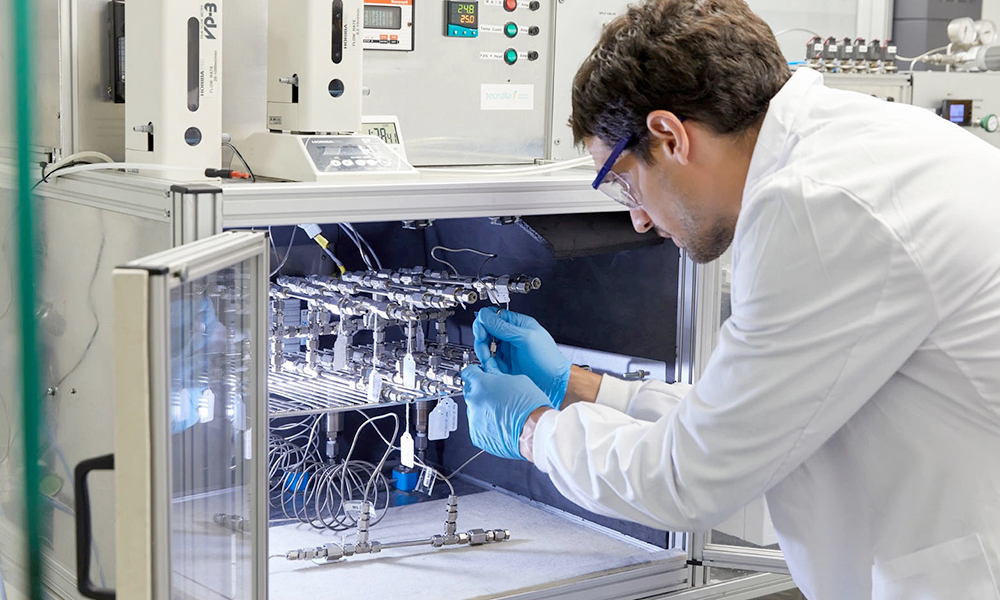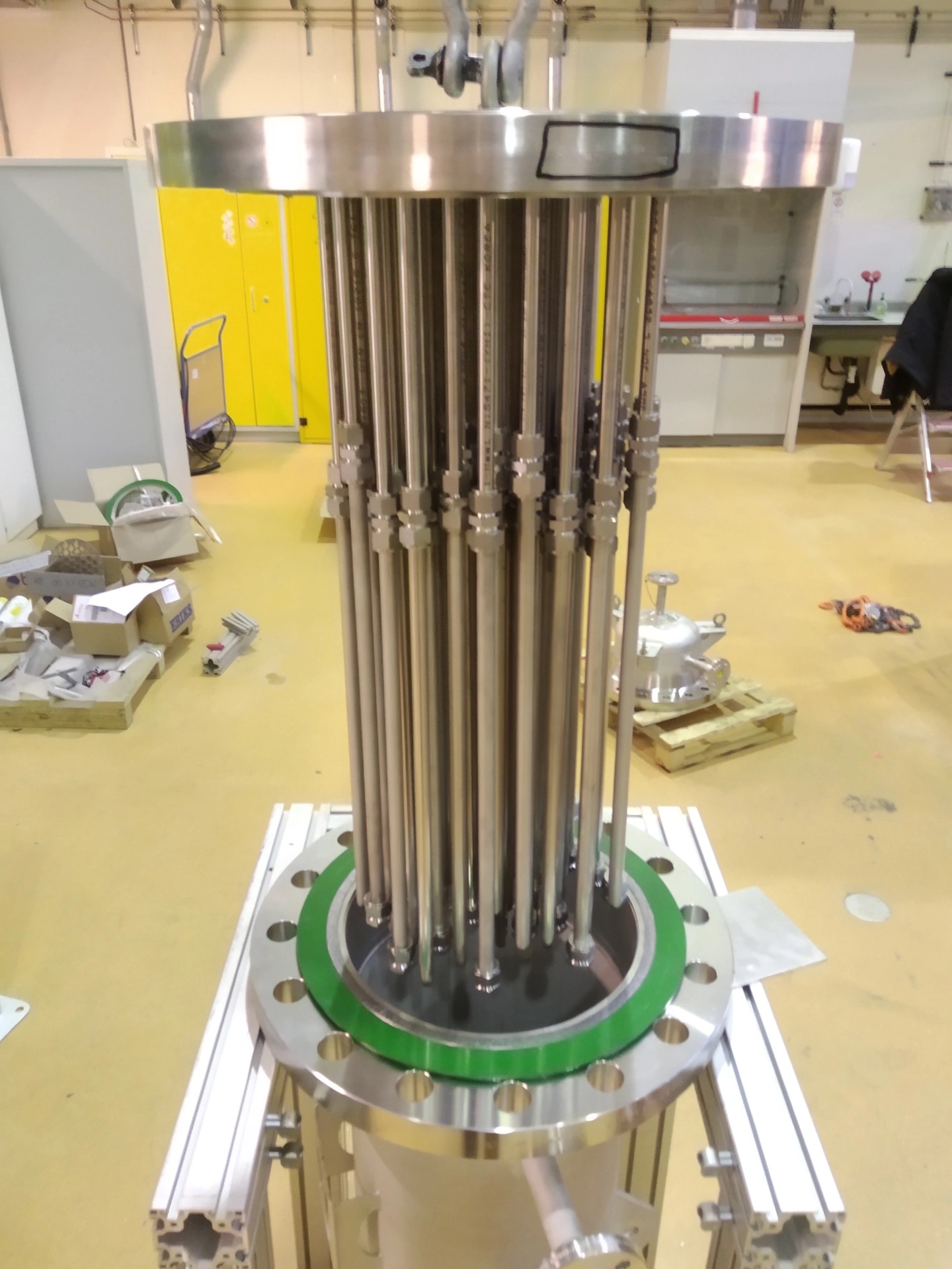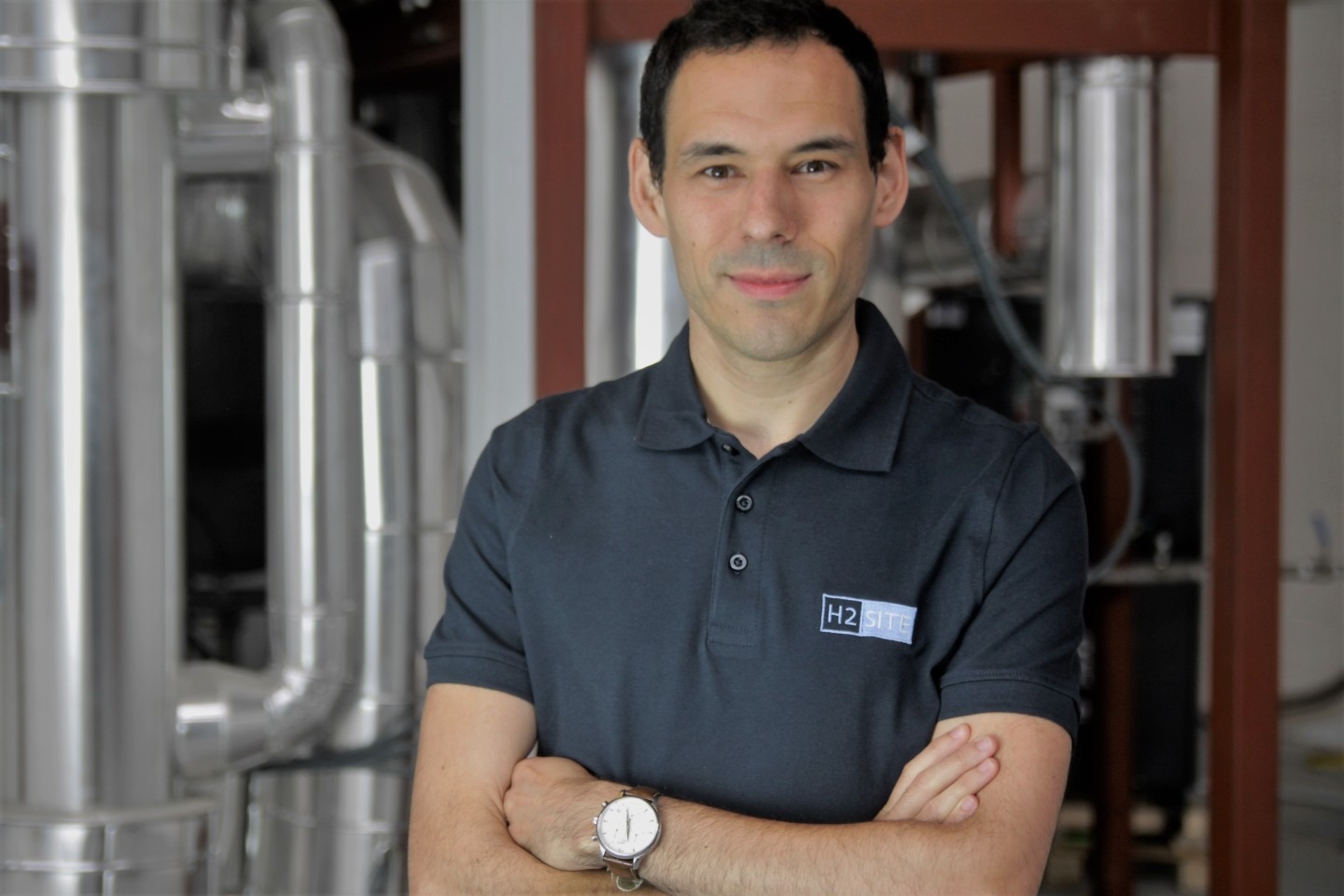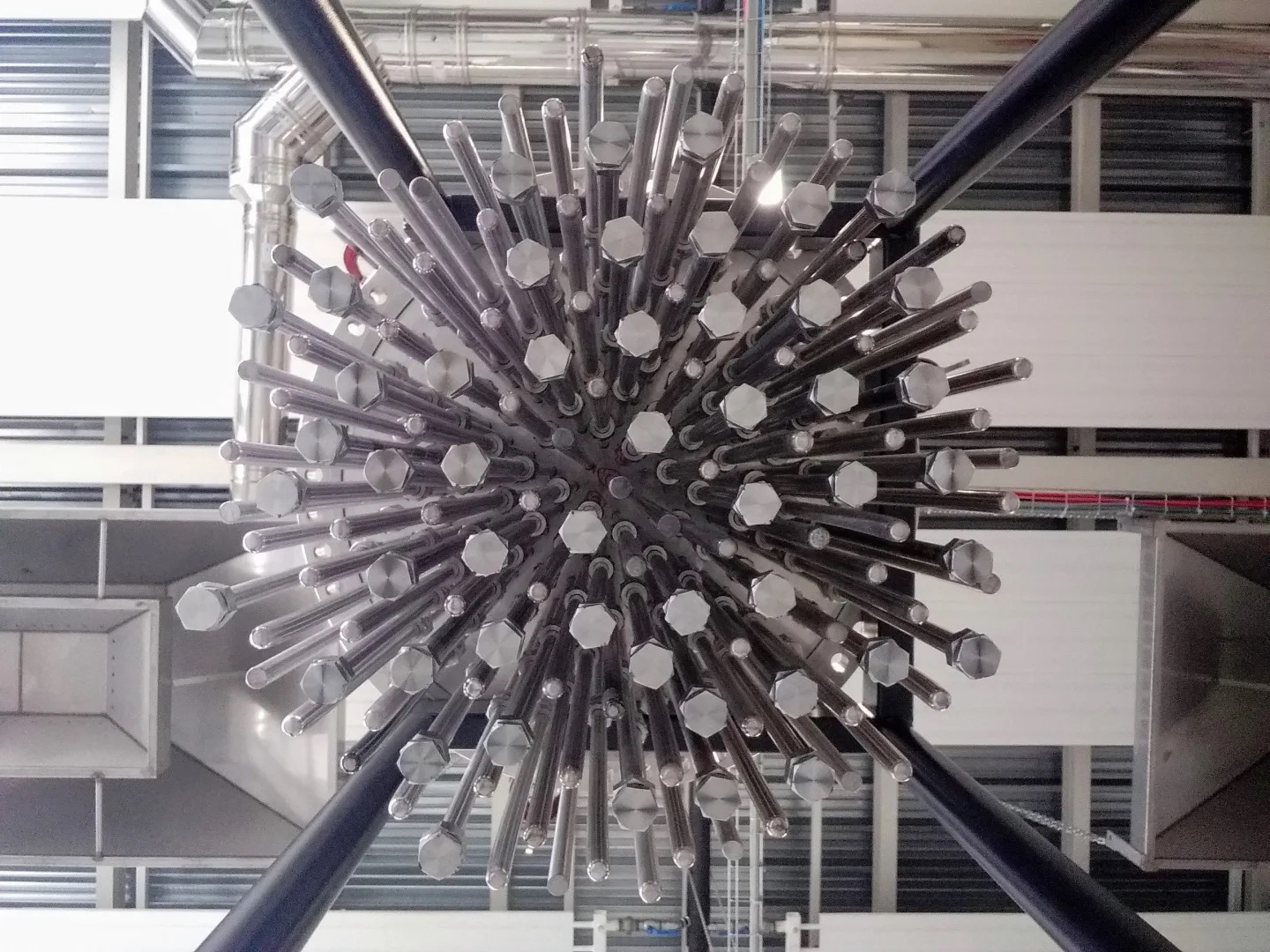
在这个迫切需要清洁能源的世界,绿氢可谓是救命稻草:零碳、储量丰富而且具有广泛用途。然而,我们依然无法充分发掘绿氢的潜力。
多年来,气候活动家一直在积极呼吁,让炼钢和原油冶炼等行业使用零碳氢燃料来脱碳,而这些行业一直都依赖 “灰氢”(化石能源制氢,生产过程中会伴随二氧化碳排放)。很快,绿氢就将成为卡车、公共汽车,甚至轮船和飞机(劳斯莱斯正在测试氢燃料飞机引擎)的燃料,并通过燃烧来供热和发电。
然而,所有这一切美好的承诺都存在一个“拦路虎”:人们当前无法以较为经济的方式大规模地把氢气从产地(利用丰富廉价的可再生能源制氢)运输到使用地,例如从西班牙运输至北非、阿曼和澳大利亚。
西班牙氢气运输初创企业H2SITE首席执行官安德烈斯·加纳雷斯(Andrés Galnares)表示:“运输是氢气利用的痛点。”针对这一难题, H2SITE给出的解决方案是一种膜反应器(membrane reactor),这是一种过滤系统,能够让现有的管道迅速、低成本地将绿氢从产地运输至最需要的地方。
H2SITE 6月份获得1250万欧元(约合1280万美元)的A轮融资,由比尔·盖茨创立的Breakthrough Energy Ventures领投。该公司将用这笔资金打造其首款商用反应器,以便从氢气混合气体中提取纯净的氢气,而此时,俄乌冲突正导致全球绿氢需求飙升。
战时紧迫性
绿氢是利用可再生能源发电,再利用电解水制氢,这个过程能够将水分解成氧气和氢气,而氧气可重新释放至大气中。氢气则与氧气重新混合转化为燃料来发电,或像天然气一样燃烧,用于工业和民用用途。
俄乌冲突让欧洲天然气价格上涨至冲突前常规价格的五倍(而且往往要高得多),同时也抬升了绿氢的地位,及其替代碳基燃料的潜力。由于迫切希望摆脱对俄罗斯的依赖,欧盟5月份将其2030年绿氢用量目标调高了三倍,达到了2000万吨/年,其中半数将在欧洲生产。
世界需要尽快解决绿氢运输的难题。

西班牙油气公司西班牙石油(CEPSA)首席执行官马腾·维茨拉尔(Maarten Wetselaar)表示:“如果仅靠自有设备,欧洲要打造内部互联的氢气市场可能需要20年的时间。”该公司将在西班牙安达卢西亚地区绿氢生产和运输领域投资50亿美元。然而,他还指出,受战时关注的刺激,从理论上来讲,这一市场的形成时间有望缩短,可能10年就够了。
管道有很多,但都不能用
欧盟称,欧洲拥有超过20万公里的天然气管道。然而,这些管道根本无法运输纯氢气这类气体。
虽然氢气也是一种气体,但其分子要比天然气小很多,而且一定浓度的氢气在通过常规的天然气铁管时,例如比例超过5%-20%,这些小分子便可以钻进钢表面的裂缝,并将其扩大,因此会降低管道的强度,这个过程被称之为脆裂。
Rystad Energy氢气业务负责人敏赫·科伊·勒(Minh Khoi Le)称,其中一个方法就是打造专用的氢气管道,全球这类管道的现有总长度约4600公里的。然而,修建这种改管道需要数十年的时间以及数百亿美元的投入。
勒说:“彻底脱碳所需要的氢气规模巨大,这也是氢气运输的挑战所在。”
H2SITE有关运输问题的答案就是:利用现有的基础设施来运输氢气,这样便可以削减这款绿色燃料流通所需的时间和费用。
试想一下将一罐苏打水倒入厨房下水道中。现在,它会顺着家中的下水管道流向街头,在那里的出口处连接一个特殊的过滤装置,然后数秒之后,你会看到苏打水会与管道中的其他液体分离,并从装置中流出,与之前在罐中的纯度没有差别。
这个比方至少形象地解释了H2SITE设备的工作原理。

H2SITE的解决方案在10多年前才开始成形,当时,两位领军科学家乔恩·梅伦德斯·雷伊(Jon Meléndez Rey)和何塞·安东尼奥·梅德拉诺(José Antonio Medrano)分别是西班牙巴斯克地区Tecnalia研究中心和荷兰埃因霍芬理工大学(Eindhoven University of Technology in the Netherlands)的博士生。梅伦德斯·雷伊当时正在开发可以从其他物质中过滤氢气的薄膜新技术,而梅德拉诺正在设计此类过滤的流程。当时存在的薄膜异常昂贵,仅用于工业用途,而且氢气回收率过低,通过的杂质过多。燃料电池用氢气的纯度必须达到99.97%。
梅伦德斯·雷伊和他的同事最终研发出了缠绕着铂箔薄膜的管子,其形状类似于毛刷上的刷毛,然后将其植入一个箱体,也就是反应器。当氢气混合物进入反应器后,这些管子会吸引氢气,然后通过箔片,向上流经管子,到达储存单元或氢气管道。借助这一技术,人们可以在现有天然气管道中注入天然气与氢气混合物。在另一端,H2SITE称其反应器可从混合气体中分离出99.97%的纯氢气,就像上面设想的苏打水场景一样。他们的系统要比现有设计便宜,而且可以回收更多的氢气。
加纳雷斯说:“如果在西班牙韦尔瓦市混入的氢气与天然气比例为1:9,那么在巴黎,只要将我的[反应器]盒子连接上天然气基础设施,就可以提取所有的氢气,而且天然气依然停留在原有的运输系统中。原本用于运输非可再生能源的基础设施如今可以运输像纯氢气这类燃料。”

2019年,梅伦德斯·雷伊和梅德拉诺在 Tecnalia和埃因霍芬理工大学的实验室团体拿出了这一技术并将其商用化,H2SITE应运而生。梅伦德斯·雷伊和梅德拉诺是公司的两位创始科学家;加纳雷斯则离开了法国公用事业公司Engie,投入了H2SITE怀中。Engie为公司提供了种子资金,而且随后与Breakthrough Energy Ventures一道成为了该公司的投资团体。
寄希望于氨
H2SITE的另一个解决方案就是通过氨来传输氢。氨是全球广泛生产的一种化合物,而且已经建立了十分明确的国际供应链。
在由梅德拉诺及其同事设计的反应器流程中,由氮和氢合成的化合物氨将通过一种由铝颗粒和其他金属(例如镍)构成的催化剂。氨会分解为氮(约占地球大气成分的78%)和氢,后者随后会通过类似的薄膜。(只有使用的氨是绿色的,此法提取的氢才会是绿色的。化肥生产商刚刚才开始生产绿氨这种产品。)
Rystad公司的勒称,这些膜反应器的过滤装置不大可能在短期内得到大量的使用,因为大多数氢气生产设施都靠近使用氢气的工业场地。然而他还指出:“如果要把氢气作为一种全球性的商品大规模铺开,这可能会成为一项关键技术。”

加纳雷斯估计,通过氢气管道运输然后对混合气体进行提取和纯化,提取一公斤氢气的成本可能低至10美分,而氨提取法的成本则达到了每公斤1.5美元。不过他提醒说,H2SITE还是家年轻的公司,如果规模化生产,成本可能会更低。
加纳雷斯拒绝透露H2SITEA轮融资后的估值。
如今,H2SITE正在打造能够日产200公斤氢气的反应器,用于为车辆的燃料电池进行补给供应。公司还在设计多单元装置,用于为船只提供动力。这些都是用绿氢取代污染燃料过程中所迈出的跬步,但其目标是为了解决新出现的紧急转型需求。(财富中文网)
译者:冯丰
审校:夏林
在这个迫切需要清洁能源的世界,绿氢可谓是救命稻草:零碳、储量丰富而且具有广泛用途。然而,我们依然无法充分发掘绿氢的潜力。
多年来,气候活动家一直在积极呼吁,让炼钢和原油冶炼等行业使用零碳氢燃料来脱碳,而这些行业一直都依赖 “灰氢”(化石能源制氢,生产过程中会伴随二氧化碳排放)。很快,绿氢就将成为卡车、公共汽车,甚至轮船和飞机(劳斯莱斯正在测试氢燃料飞机引擎)的燃料,并通过燃烧来供热和发电。
然而,所有这一切美好的承诺都存在一个“拦路虎”:人们当前无法以较为经济的方式大规模地把氢气从产地(利用丰富廉价的可再生能源制氢)运输到使用地,例如从西班牙运输至北非、阿曼和澳大利亚。
西班牙氢气运输初创企业H2SITE首席执行官安德烈斯·加纳雷斯(Andrés Galnares)表示:“运输是氢气利用的痛点。”针对这一难题, H2SITE给出的解决方案是一种膜反应器(membrane reactor),这是一种过滤系统,能够让现有的管道迅速、低成本地将绿氢从产地运输至最需要的地方。
H2SITE 6月份获得1250万欧元(约合1280万美元)的A轮融资,由比尔·盖茨创立的Breakthrough Energy Ventures领投。该公司将用这笔资金打造其首款商用反应器,以便从氢气混合气体中提取纯净的氢气,而此时,俄乌冲突正导致全球绿氢需求飙升。
战时紧迫性
绿氢是利用可再生能源发电,再利用电解水制氢,这个过程能够将水分解成氧气和氢气,而氧气可重新释放至大气中。氢气则与氧气重新混合转化为燃料来发电,或像天然气一样燃烧,用于工业和民用用途。
俄乌冲突让欧洲天然气价格上涨至冲突前常规价格的五倍(而且往往要高得多),同时也抬升了绿氢的地位,及其替代碳基燃料的潜力。由于迫切希望摆脱对俄罗斯的依赖,欧盟5月份将其2030年绿氢用量目标调高了三倍,达到了2000万吨/年,其中半数将在欧洲生产。
世界需要尽快解决绿氢运输的难题。
西班牙油气公司西班牙石油(CEPSA)首席执行官马腾·维茨拉尔(Maarten Wetselaar)表示:“如果仅靠自有设备,欧洲要打造内部互联的氢气市场可能需要20年的时间。”该公司将在西班牙安达卢西亚地区绿氢生产和运输领域投资50亿美元。然而,他还指出,受战时关注的刺激,从理论上来讲,这一市场的形成时间有望缩短,可能10年就够了。
管道有很多,但都不能用
欧盟称,欧洲拥有超过20万公里的天然气管道。然而,这些管道根本无法运输纯氢气这类气体。
虽然氢气也是一种气体,但其分子要比天然气小很多,而且一定浓度的氢气在通过常规的天然气铁管时,例如比例超过5%-20%,这些小分子便可以钻进钢表面的裂缝,并将其扩大,因此会降低管道的强度,这个过程被称之为脆裂。
Rystad Energy氢气业务负责人敏赫·科伊·勒(Minh Khoi Le)称,其中一个方法就是打造专用的氢气管道,全球这类管道的现有总长度约4600公里的。然而,修建这种改管道需要数十年的时间以及数百亿美元的投入。
勒说:“彻底脱碳所需要的氢气规模巨大,这也是氢气运输的挑战所在。”
H2SITE有关运输问题的答案就是:利用现有的基础设施来运输氢气,这样便可以削减这款绿色燃料流通所需的时间和费用。
试想一下将一罐苏打水倒入厨房下水道中。现在,它会顺着家中的下水管道流向街头,在那里的出口处连接一个特殊的过滤装置,然后数秒之后,你会看到苏打水会与管道中的其他液体分离,并从装置中流出,与之前在罐中的纯度没有差别。
这个比方至少形象地解释了H2SITE设备的工作原理。
H2SITE的解决方案在10多年前才开始成形,当时,两位领军科学家乔恩·梅伦德斯·雷伊(Jon Meléndez Rey)和何塞·安东尼奥·梅德拉诺(José Antonio Medrano)分别是西班牙巴斯克地区Tecnalia研究中心和荷兰埃因霍芬理工大学(Eindhoven University of Technology in the Netherlands)的博士生。梅伦德斯·雷伊当时正在开发可以从其他物质中过滤氢气的薄膜新技术,而梅德拉诺正在设计此类过滤的流程。当时存在的薄膜异常昂贵,仅用于工业用途,而且氢气回收率过低,通过的杂质过多。燃料电池用氢气的纯度必须达到99.97%。
梅伦德斯·雷伊和他的同事最终研发出了缠绕着铂箔薄膜的管子,其形状类似于毛刷上的刷毛,然后将其植入一个箱体,也就是反应器。当氢气混合物进入反应器后,这些管子会吸引氢气,然后通过箔片,向上流经管子,到达储存单元或氢气管道。借助这一技术,人们可以在现有天然气管道中注入天然气与氢气混合物。在另一端,H2SITE称其反应器可从混合气体中分离出99.97%的纯氢气,就像上面设想的苏打水场景一样。他们的系统要比现有设计便宜,而且可以回收更多的氢气。
加纳雷斯说:“如果在西班牙韦尔瓦市混入的氢气与天然气比例为1:9,那么在巴黎,只要将我的[反应器]盒子连接上天然气基础设施,就可以提取所有的氢气,而且天然气依然停留在原有的运输系统中。原本用于运输非可再生能源的基础设施如今可以运输像纯氢气这类燃料。”
2019年,梅伦德斯·雷伊和梅德拉诺在 Tecnalia和埃因霍芬理工大学的实验室团体拿出了这一技术并将其商用化,H2SITE应运而生。梅伦德斯·雷伊和梅德拉诺是公司的两位创始科学家;加纳雷斯则离开了法国公用事业公司Engie,投入了H2SITE怀中。Engie为公司提供了种子资金,而且随后与Breakthrough Energy Ventures一道成为了该公司的投资团体。
寄希望于氨
H2SITE的另一个解决方案就是通过氨来传输氢。氨是全球广泛生产的一种化合物,而且已经建立了十分明确的国际供应链。
在由梅德拉诺及其同事设计的反应器流程中,由氮和氢合成的化合物氨将通过一种由铝颗粒和其他金属(例如镍)构成的催化剂。氨会分解为氮(约占地球大气成分的78%)和氢,后者随后会通过类似的薄膜。(只有使用的氨是绿色的,此法提取的氢才会是绿色的。化肥生产商刚刚才开始生产绿氨这种产品。)
Rystad公司的勒称,这些膜反应器的过滤装置不大可能在短期内得到大量的使用,因为大多数氢气生产设施都靠近使用氢气的工业场地。然而他还指出:“如果要把氢气作为一种全球性的商品大规模铺开,这可能会成为一项关键技术。”
加纳雷斯估计,通过氢气管道运输然后对混合气体进行提取和纯化,提取一公斤氢气的成本可能低至10美分,而氨提取法的成本则达到了每公斤1.5美元。不过他提醒说,H2SITE还是家年轻的公司,如果规模化生产,成本可能会更低。
加纳雷斯拒绝透露H2SITEA轮融资后的估值。
如今,H2SITE正在打造能够日产200公斤氢气的反应器,用于为车辆的燃料电池进行补给供应。公司还在设计多单元装置,用于为船只提供动力。这些都是用绿氢取代污染燃料过程中所迈出的跬步,但其目标是为了解决新出现的紧急转型需求。(财富中文网)
译者:冯丰
审校:夏林
In a world desperate for clean energy, green hydrogen ticks a lot of boxes—it’s zero-carbon, abundant, and versatile. Yet harnessing green hydrogen’s full potential remains just out of reach.
For years, climate activists have buzzed about zero-carbon hydrogen fuel as a way to decarbonize industries like steel production and oil refining that rely on its dirty cousin—“gray” hydrogen, made from natural gas. And soon green hydrogen could power trucks, buses and eventually ships and planes (Rolls-Royce is testing a hydrogen-powered airplane engine), and be burned to generate heat and electricity.
But all that promise comes with a catch: There’s currently no way to transport hydrogen, economically and at scale, from locations where it can be made with copious and cheap renewable energy—from Spain to northern Africa, Oman, and Australia—to the sites where it would be used.
“From a transport perspective, it’s a pain in the neck,” says Andrés Galnares, chief executive of H2SITE, a Spanish hydrogen transport startup. H2SITE’s solution to the problem is a membrane reactor—a kind of filter system—that allows existing pipelines to quickly and cheaply carry green hydrogen from where it’s produced to where it’s needed needed most.
The company in June received 12.5 million euros ($12.8 million) in a Series A funding round led by the Bill Gates–founded Breakthrough Energy Ventures: money that H2SITE will use to build its first commercial reactors to extract pure hydrogen from compounds into which is it blended—just as Russia’s invasion of Ukraine causes global demand for green hydrogen to skyrocket.
Wartime urgency
Green hydrogen is produced by blasting renewably generated electricity through water in a device called an electrolyzer—a process that separates the water into oxygen, which can be released into the atmosphere, and hydrogen (H2). Hydrogen is turned into fuel by recombining it with oxygen to produce electricity or by burning it like natural gas for industrial and residential uses.
Russia’s war in Ukraine, which sent European natural gas to five times (and often much more) its typical pre-conflict price, raised the profile of green hydrogen and its potential to replace carbon-based fuels. Eager to wean itself from Russian dependence, the European Union in May quadrupled its 2030 goal for green hydrogen usage to 20 million tonnes a year—half to be produced in Europe.
The world needs to solve green hydrogen’s transportation conundrum—and fast.
“Left to its own devices, a market for hydrogen in Europe that has interconnectivity is probably 20 years away,” says Maarten Wetselaar, CEO of CEPSA, a Spanish oil and gas company that is investing $5 billion in green hydrogen production and transport in the Andalusia region of Spain. But, he adds, motivated by a wartime focus, it could technically be created in less time—maybe a decade.
Lots of pipes, but not the right ones
Europe is home to more than 200,000 kilometers of natural gas pipelines, according to the EU. But those pipes can’t carry anything close to pure hydrogen.
Hydrogen is a gas, but it is a much smaller molecule than natural gas, and if a high concentration of it—more than 5%–20%, depending on the pipe—is sent through typical steel natural gas pipes, the tiny molecules can creep into minute cracks in the steel and widen them, thus weakening the pipe—a process called embrittlement.
One option is to build dedicated hydrogen pipelines—there are about 4,600 kilometers of these in the world, according Minh Khoi Le, head of hydrogen research at Rystad Energy—but that will take decades and billions of dollars.
“The challenge with hydrogen transport is to do it on a big scale so that we can decarbonize completely,” says Le.
H2SITE’s answer to the transport problem is to pump hydrogen through existing infrastructure and thus cut the time and expense required to get the green fuel flowing.
Imagine pouring a can of soda down your kitchen sink. Now, run down to where your home’s drainage pipe heads out to the street. There, stick a special filter in the pipe, and a few seconds later, watch as soda pours out of it, separated from everything else flowing through the pipe, as pure as when it left the can.
That, at least metaphorically, is how H2SITE’s equipment works.
H2SITE’s solution began to take shape just over a decade ago when its two lead scientists—Jon Meléndez Rey and José Antonio Medrano—were Ph.D. students at Tecnalia, a research center in Spain’s Basque country, and the Eindhoven University of Technology in the Netherlands, respectively. Meléndez Rey was developing the nascent technology behind membranes that could filter hydrogen from other substances, while Medrano’s was designing the process behind such filtering. The membranes that existed at the time were prohibitively expensive for industrial use, recovered too little hydrogen, and allowed too many impurities through. For hydrogen to be used in fuel cells, it must be 99.97% pure.
What Meléndez Rey and his colleagues landed on are essentially tubes wrapped with a membrane of palladium foil that are grouped like bristles on a hairbrush and then inserted into a tank—the reactor. Once a hydrogen mix enters the reactor, the tubes attract the hydrogen, which then passes through the foil and flows up through the tube to a storage unit or a hydrogen pipeline. With this technology, a mix of natural gas and hydrogen could be injected into an existing natural gas pipeline, and at the other end, H2SITE says its reactors can suck 99.97% pure hydrogen from the mix—just like the imaginary soda. Their system is cheaper than existing designs and can recover more hydrogen.
“Say you inject 10% hydrogen and 90% natural gas in Huelva, Spain,” Galnares says. “In Paris, I connect one of my [reactor] boxes to the natural gas infrastructure and I extract all the hydrogen and the natural gas continues in its old transport system. Infrastructure meant to transport nonrenewables can now transport fuel like pure hydrogen.”
In 2019, Meléndez Rey and Medrano’s laboratory groups at Tecnalia and TU Eindhoven spun out their technology to commercialize it, and H2SITE was born. Meléndez Rey and Medrano were its two founding scientists; Galnares joined from the French utility company Engie, which provided seed funding and was later part of the consortium that invested alongside Breakthrough Energy Ventures.
Ammonia road
Another H2SITE solution is to transport hydrogen via ammonia, a widely produced chemical compound that already has a well-defined international supply chain.
In a reactor process designed by Medrano and his colleagues, ammonia, a compound made of nitrogen and hydrogen, is passed through a catalyzer made up of aluminum particles and other metals such as nickel. The ammonia breaks into nitrogen—which makes up about 78% of the Earth’s atmosphere—and hydrogen, which then passes through the same membrane. (The hydrogen extracted this way would only be green if the ammonia were “green”—a product fertilizer makers are just starting to produce.)
According to Le of Rystad, these membrane reactor filters are unlikely to be much used in the short term, as most hydrogen production facilities are being built near the industrial sites where they will be used. But, he says, “it could be a crucial technology when you look to scale up hydrogen to be a global commodity.”
Galnares estimates the cost of extracting a kilogram of hydrogen would run from as little as 10 cents—to purify hydrogen that’s sent through a hydrogen pipeline and picked up impurities on the way—to $1.50 for extracting it from ammonia, though he cautions that H2SITE is a young company, and the costs could come down if it can scale.
Galnares declined to reveal H2SITE’s Series A valuation.
Today, H2SITE is building reactors that can make 200 kilograms of hydrogen a day to resupply vehicle fuel cells. It’s also designing multiton units to power ships. These are small steps toward replacing dirty fuels with green hydrogen, but ones that point to the newfound urgency of the transition.






